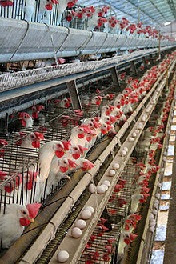Poultry Farming Business – What You Should Know – among the things you should know are; how to run a poultry farm, layers poultry farming in Nigeria, how to start a poultry farm, profitability of poultry farming in Nigeria, feasibility study on poultry farming in Nigeria, poultry farming in Nigeria, poultry farming in Nigeria manual, poultry farming techniques. Just read on. Most of these issues will be dealt with in this article.
We are dedicated to articles that engenders business ideas and business procedures for start-up businesses and growth processes for existing businesses. In this article, Poultry Farming Business – What You Should Know, we have tried to introduce what the ordinary businessman should know about poultry farming so as to enable him/her make his investment decisions. The follow-up of this article will be on how to get a wining business plan for poultry business. We encourage you to follow up this article.
Poultry Farming Business – What You Should Know
The Nature of Poultry Farming:
Poultry farming is a global business idea. It is so because all over the world in various countries poultry products are considered as important food item. Again, it has become so much a lucrative business and attracts both national and global attentions. In addition, it is also important because it is becoming an important foreign exchange earning business for many countries.
In the first place, poultry farming is the process of raising domesticated birds such as chickens, ducks, turkeys and geese for the purpose of producing meat
or eggs for food. Poultry are farmed in great numbers with chickens being the most numerous. Chickens raised for eggs are usually called layers while chickens raised for meat are called broilers.
The two ways of poultry farming are the intensive method and the free-range method.These are the two types we consider here because they are done in an industrial manner. Other forms of domestic poultry raising are not considered because in most cases they are for family use or for part-time efforts.
Commercially they are not so relevant to business decisions and they contribute very little to a national gross domestic product and dos not affect country’s foreign trade, except to the fact that if one consumes what he/she produces he/she will no longer buy from the markets. However, the knowledge revealed here will help very shade of poultry keeper.
What hen is the intensive or industrial method like and how is it done? Check out on Poultry Farming Business – What You Should KnowIntensive animal farming or industrial livestock production is a modern form of intensive farming that refers to the keeping of livestock, such as poultry at higher stocking densities This is a practice that is typical in industrial farming by agribusinesses. The main products of this industry are meat, milk and eggs for human consumption. This Confinement at high stocking density is one part of a systematic effort to produce the highest output at the lowest cost by relying on economies of scale, modern machinery, biotechnology, and global trade.
And Free-range method is like what?
Free-range chickens are fed outdoors. Free-range poultry farming allows chickens to roam freely for a period of the day, although they are usually confined in sheds at night to protect them from predators or kept indoors if the weather is particularly bad. This type requires suitable land, adequate drainage to minimise worms, suitable protection from prevailing winds, good ventilation, access and protection from predators.
Poultry Farming Business – What You Should Know
Poultry Business Slogans and farming methods adopted:
The following are explanation of certain concepts that are involved in poultry farming, which are very necessary for intending businessman to know. Their applications also depends on the method of farming production adopted.
Commercial hens usually begin laying eggs at 16–20 weeks of age, although production gradually declines soon after from approximately 25 weeks of age. Note that more egg production occur in the warmer months. Some commercial breeds of hen can produce over 300 eggs a year.
In organic egg-laying systems, chickens are also free-range. Organic systems are based upon restrictions on the routine use of synthetic yolk colourants, in-feed or in-water medications, other food additives and synthetic amino acids, and a lower stocking density and smaller group sizes.
Yarding type of poultry farming:
While often confused with free-range farming, yarding is actually a separate method of poultry culture by which chickens and cows are raised together. The distinction is that free-range poultry are either totally unfenced, or the fence is so distant that it has little influence on their freedom of movement.
Yarding is common technique used by small farms in the Northeastern US. The birds are released daily from hutches or coops. The hens usually lay eggs either on the floor of the coop or in baskets if provided by the farmer. This husbandry technique can be complicated if used with roosters, mostly because of aggressive behaviour.
Battery cages for layer hens for Poultry Farming Business – What You Should Know
The majority of hens in many countries are reared in battery cages. These are small cages, usually made of metal in modern systems, housing 3 to 8 hens. The walls are made of either solid metal or mesh, and the floor is sloped wire mesh to allow the faeces to drop through and eggs to roll onto an egg-collecting conveyor belt.
Water is usually provided by overhead nipple systems, and food in a trough along the front of the cage replenished at regular intervals by a mechanical chain.
The cages are arranged in long rows as multiple tiers, often with cages back-to-back (hence the term ‘battery cage’). Within a single shed, there may be several floors containing battery cages meaning that a single shed may contain many tens of thousands of hens. Light intensity is often kept low to reduce feather pecking and vent pecking.
Consequently, the benefits of battery cages include easier care for the birds, floor eggs which are expensive to collect are eliminated, eggs are cleaner, capture at the end of lay is expedited, generally less feed is required to produce eggs, broodiness is eliminated, more hens may be housed in a given house floor space, internal parasites are more easily treated, and labour requirements are generally much reduced.
Furnished cages, sometimes called ‘enriched’ or ‘modified’ cages, are cages for egg laying hens which have been designed to overcome some of the welfare concerns of battery cages whilst retaining their economic and husbandry advantages, and also provide some of the welfare advantages of non-cage systems.
Many design features of furnished cages have been incorporated because it is of great benefit to the hens. Furnished cages should provide at least 750 cm2 of cage area per hen, 600 cm2 of which should be usable; the height of the cage other than that above the usable area should be at least 20 cm at every point and no cage should have a total area that is less than 2000 cm2. In addition, furnished cages should provide a nest, litter such that pecking and scratching are possible, appropriate perches allowing at least 15 cm per hen, a claw-shortening device, and a feed trough which may be used without restriction providing 12 cm per hen.
Broiler industry: Poultry Farming Business – What You Should Know
Meat chickens, commonly called broilers, are floor-raised on litter such as wood shavings, peanut shells, and rice hulls, indoors in climate-controlled housing. Under modern farming methods, meat chickens reared indoors reach slaughter weight at 5 to 9 weeks of age.
The first week of chickens life they can grow 300 percent of their body size, a nine-week-old chicken can average over 9 pounds in body weight. At nine weeks a hen will average around 7 pounds and a rooster will weigh around 12 pounds, having a nine-pound average.
Poultry Farming Business – What You Should Know
Broilers are not raised in cages. They are raised in large, open structures known as grow out houses. A farmer receives the birds from the hatchery at one day old. A grow out consist of 5 to 9 weeks according on how big the kill plant wants the chickens to be.
These houses are equipped with mechanical systems to deliver feed and water to the birds. They have ventilation systems and heaters that function as needed. The floor of the house is covered with bedding material consisting of wood chips, rice hulls, or peanut shells. In some cases they can be grown over dry litter or compost. Because dry bedding helps maintain flock health, most grow-out houses have enclosed watering systems.
Keeping birds inside a house protects them from predators such as hawks and foxes. Some houses are equipped with curtain walls, which can be rolled up in good weather to admit natural light and fresh air.
Chicken feed consists primarily of corn and soybean meal with the addition of essential vitamins and minerals. No hormones or steroids are allowed in raising chickens.
Free-range broilers: 0n Poultry Farming Business – What You Should Know
Free-range broilers are reared under similar conditions to free-range egg laying hens. The breeds grow more slowly than those used for indoor rearing and usually reach slaughter weight at approximately 8 weeks of age.
The benefits of free-range poultry farming include opportunities for natural behaviours such as pecking, scratching, foraging and exercise outdoors. Because they grow slower and have opportunities for exercise, free-range broilers often have better leg and heart health.
Organic broiler chickens are reared under similar conditions to free-range broilers but with restrictions on the routine use of in-feed or in-water medications, other food additives and synthetic amino acids. The breeds used are slower growing, more traditional breeds and typically reach slaughter weight at around 12 weeks of age.
Poultry Farming Business – What You Should Know
On Poultry Farming Business – What You Should Know, are you a small business owner or entrepreneur, Complete Full Marks has business information to help you take your next steps. This is because we are a comprehensive one-stop shop for all your business start-up needs. Therefore, explore this opportunity provided here to make your business work well. Call +234 8034347851 or [email protected]
Deacon Anekperechi Nworgu, a seasoned economist who transitioned into a chartered accountant, auditor, tax practitioner, and business consultant, brings with him a wealth of industry expertise spanning over 37 years.




